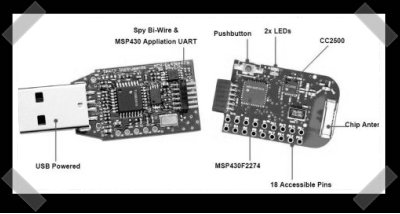
[nazerine] sent in [Emanuele]’s list of interesting USB micro-controller development tools. Some of them are surprisingly cheap for what you get. The wireless dev/emulator stick looks extra interesting for developing remote projects. (The purchase links are through the manufacturer – at first I thought he might be selling the things)
8 thoughts on “USB Microcontroller Dev/emulation Sticks”
Leave a Reply
Please be kind and respectful to help make the comments section excellent. (Comment Policy)
















Yea, these have been around for a while. TI has annual conferences across the country (which are free) called 430 day (their processor is the MSP430 for those who didn’t already know). At the conferences they basically give you a run down of the families features, feed you and send you off with a free development kit. I got two of the 2nd one pictured at the last 430 day.
yah i have been using the eZ430 for about a month now for little things
Like the post above, the MSP430 has been around for awhile. About 5 years. They have a very easy to use IDE which is free. They are also known for being good at saving power.
Anyways I thought I add that I just got the RF kit the other day. Very very nice quality kit. I haven’t had the chance to tinker around with them yet, but I plan on making full use of the RF capability. ;)
my design group at a major US university is using one of these to prototype an extremely low-power medical monitor. with 2 integrated op-amps, a 10-bit adc, internal ultralow-power 32khz clock, and UART/SPI capabilities, it’s hard to go wrong.
I work for TI, but not on the MSP430. There was a tech demo with the MSP430 running a mini weather station (barometer, wind, humidity, temp). The whole thing was powered by a potato. The 430 is a sweet little low power device, not at all like the OMAP I work on.
Methinks it’s time to get a box of samples and make my toaster sing and dance.
Well, this will certainly enlarge my ARM devboards collection. Thank you.
I’ve been using the MPS430 for a few years now. I love it! Very easy to use, lots of adaptability.
I use and like the eZ430 F2013 stick, but the eZ430-RF2500 wireless dev stick was a disappointment because of weak documentation. All you get is one example application that runs TI’s proprietary networking stack. If you just want to learn how to configure and use the wireless chip on the board and send a simple packet, there’s nothing to help you, and the chip-configuring code in the example app is packed into compiled libraries so you can’t study it.
BTW, I wonder if everyone trying to get some range out of their Nordic and Chipcon wireless gadgets knows that a milliwatt at 2.5 GHz is only a tenth as effective as a milliwatt on 458 MHz? Stick with Lynx, I say.